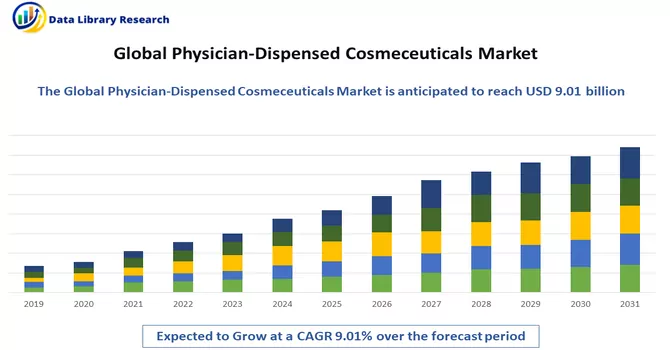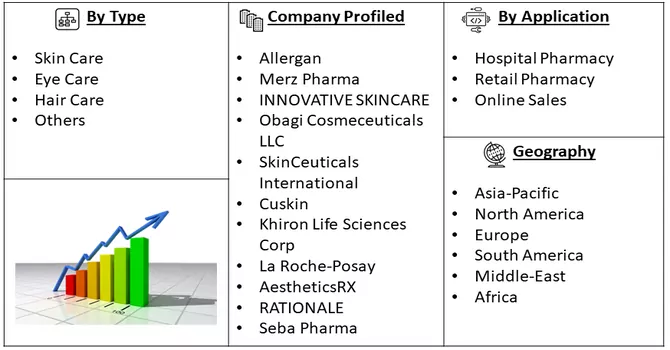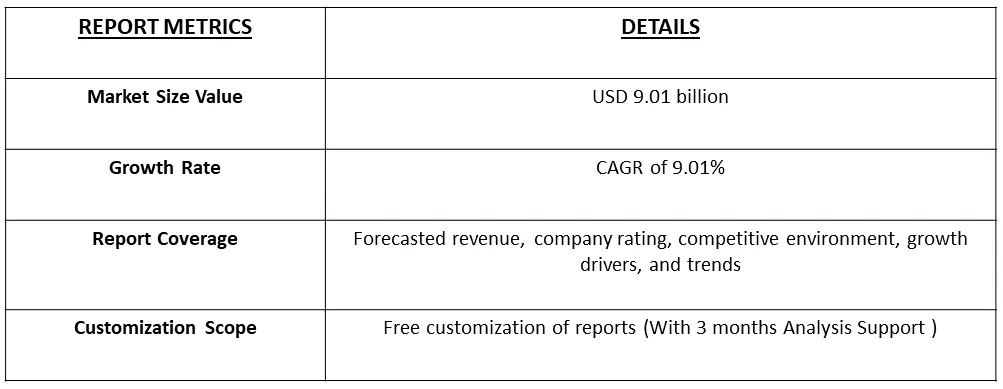The Physician Dispensed Cosmeceuticals Market size was valued at USD 9.01 billion in 2022 & is projected a CAGR of 9.01% over the forecast period, 2023-2030.

Get Complete Analysis Of The Report - Download Free Sample PDF
The sector of physician-dispensed cosmeceuticals revolves around skincare items typically distributed or advised by medical professionals such as dermatologists, plastic surgeons, or aestheticians. This category represents a fusion of cosmetics and pharmaceuticals, featuring formulations with active ingredients designed to deliver specific skincare benefits, including but not limited to anti-aging, acne treatment, and skin rejuvenation.
The endorsement or recommendation of these products by healthcare professionals imparts a heightened perceived value, instilling trust in consumers. These cosmeceuticals are characterized by elevated concentrations of active ingredients, often developed through rigorous scientific research and clinical studies, resulting in a higher efficacy compared to over-the-counter alternatives.
The increasing emphasis on beauty, coupled with a growing awareness of the benefits associated with physician-endorsed cosmeceuticals, is propelling the expansion of this market. Consumers are seeking advanced skincare solutions supported by science and professional recommendations, driving the popularity of products that bridge the gap between cosmetics and pharmaceuticals.
A noticeable shift is underway towards personalized skincare regimens tailored to individual needs, reflecting a growing inclination among consumers for targeted solutions. Physicians are increasingly leveraging technology, such as skin analysis tools, DNA testing, and assessments of lifestyle factors, to craft customized skincare plans for their patients. This aligns seamlessly with consumers' preferences for products that specifically address their unique skin concerns, giving rise to the emergence of personalized cosmeceuticals. Moreover, the consumers are becoming more discerning about the ingredients in their skincare products, displaying a preference for formulations that are natural, organic, and considered clean. This preference extends to the realm of physician-dispensed cosmeceuticals, where there is a surging demand for products featuring botanical extracts, vitamins, and naturally derived active ingredients. Recognizing this demand, brands are actively responding by formulating products that not only deliver effectiveness but also embrace clean and eco-friendly ingredients. This trend underscores a collective desire for skincare solutions that are not only potent but also align with the principles of safety and environmental consciousness.
Market Segmentations: The Physician Dispensed Cosmeceuticals Market is segmented by Type (Skin Care, Eye Care, Hair Care and Others), and Geography (North America, Europe, Asia-Pacific, Middle East and Africa, and South America). The report offers the value (in USD million) for the above segments.

For Detailed Market Segmentation - Download Free Sample PDF
Market Drivers:
Increasing Demand for Anti-Aging Products
The escalating aging demographic, particularly in developed nations, has triggered a substantial upswing in the need for anti-aging solutions. Consumers are now more than ever in search of products that specifically tackle concerns associated with aging, such as wrinkles, fine lines, age spots, and diminished skin elasticity. In response to this demand, physician-dispensed cosmeceuticals have emerged as a sought-after category, offering sophisticated formulations enriched with active ingredients like retinoids, peptides, antioxidants, and growth factors. These components are rigorously tested and clinically proven to address signs of aging more effectively than conventional cosmetics.
The contemporary emphasis on maintaining a youthful appearance has led individuals to invest significantly in skincare, driving the sustained growth of the market for specialized physician-recommended products. The advanced nature of these cosmeceuticals, coupled with their scientific backing and clinically validated ingredients, positions them as preferred choices for those prioritizing effective solutions in their anti-aging skincare routines. As the aging population continues to expand and the desire for targeted, results-driven products intensifies, the demand for physician-dispensed cosmeceuticals is poised to maintain its upward trajectory. Thus, such factors are expected to drive the growth f the studied market over the forecast period.
Growing Emphasis on Skincare and Wellness
There's a shifting trend toward proactive skincare and overall wellness. Consumers are becoming more conscious of maintaining healthy skin and preventing skin issues before they arise. This shift involves a broader understanding that skincare goes beyond cosmetics and includes using scientifically backed products with dermatologist-recommended formulations. Physician-dispensed cosmeceuticals are perceived as superior due to their higher concentrations of active ingredients, backed by scientific research and medical expertise. The emphasis on holistic wellness and the role of skincare in maintaining overall health has led to an increased acceptance and demand for these physician-recommended products. Thus, such factors are expected to drive the growth f the studied market over the forecast period.
Market Restraints:
Regulatory Hurdles and Compliance Challenges and High Costs and Accessibility:
The operating within a regulatory landscape that frequently blurs the distinctions between cosmetics and pharmaceuticals, the cosmeceuticals industry encounters challenges in achieving compliance, especially when formulating products with heightened concentrations of active ingredients. The stringent regulations governing labeling, claims, and ingredient safety pose hurdles that can impede product development and marketing strategies. Navigating these regulatory requirements not only extends product development cycles but also amplifies costs, potentially acting as a deterrent to innovation within the industry. Moreover, physician-dispensed cosmeceuticals, renowned for their incorporation of advanced and clinically proven ingredients, often come with a premium price tag compared to over-the-counter cosmetics. The elevated cost is attributed to factors such as premium quality, the inclusion of potent active ingredients, and the endorsement by medical professionals. While these aspects contribute to the products' efficacy, affordability becomes a concern for a segment of consumers. Moreover, the accessibility of physician-dispensed cosmeceuticals may be restricted to individuals with access to dermatologists or specialized clinics, limiting their availability to a broader consumer base.
Amid the pandemic, consumer priorities underwent a significant shift. With limited access to in-person consultations and elective procedures, visits to dermatologists and aesthetic clinics experienced a temporary decline. Consequently, the sales of physician-dispensed cosmeceuticals, typically distributed through traditional channels like in-office sales, were adversely affected. Consumers, mindful of discretionary spending, displayed increased caution, impacting the demand for premium-priced skincare products. The pandemic expedited the adoption of telemedicine and e-commerce platforms.
For example, the article titled 'Shifts in Consumer Awareness and Interest in Cosmetic Products Amid the Pandemic,' published in January 2022. The findings indicated that consumers globally recognized the significance of skincare during the pandemic, leading to a positive impact on the skincare product market. The same source highlighted that the prolonged use of face masks in the current situation has resulted in consumers experiencing acne issues, prompting an increased focus on skincare products.
These circumstances present a compelling case for the acceptance and utilization of physician-dispensed (prescribed) cosmetics amid the pandemic.
In response to the limitations posed by in-person consultations, physicians adapted by providing virtual consultations and remotely offering skincare recommendations. This adaptation resulted in a notable surge in online sales of cosmeceuticals, as consumers sought skincare solutions from the safety and comfort of their homes. The convenience and accessibility facilitated by e-commerce platforms emerged as pivotal factors in sustaining sales during periods of lockdowns and restrictions.
Segmentation Analysis:
Skin Care Segment is Expected to Witness Significant Growth Over the Forecast Period
Skincare within the physician-dispensed cosmeceuticals industry includes a wide range of products targeting various skin concerns, such as anti-aging, acne, hyperpigmentation, hydration, and sensitivity. These products often contain higher concentrations of active ingredients like retinoids, antioxidants, hyaluronic acid, alpha hydroxy acids (AHAs), and peptides. Dermatologists or skincare professionals recommend these products based on individual skin types and concerns. They may include serums, moisturizers, cleansers, exfoliants, and specialized treatments.
Moreover, there is an increasing awareness among consumers about the importance of skincare for maintaining healthy and radiant skin. This awareness has led to a growing demand for a wide range of skincare products. The skincare segment encompasses a diverse range of products, including cleansers, moisturizers, serums, masks, and specialized treatments. This diversity allows consumers to tailor their skincare routines based on their unique needs and preferences. Thus, owing to such advantages, the segment is expected to witness significant growth over the forecast period.
North America Region is Expected to Witness Significant Growth Over the Forecast Period
The region possesses a sophisticated healthcare infrastructure, characterized by well-established dermatological practices and clinics. These environments create a favorable setting for physicians to dispense cosmeceutical products and offer personalized skincare consultations, contributing significantly to the industry's growth.
In the United States, the regulation of cosmeceuticals falls under the purview of the Food and Drug Administration (FDA), operating in accordance with the Federal Food, Drug, and Cosmetic Act (FD&C Act) and the Fair Packaging and Labeling Act (FPLA). According to a February 2022 press release from the FDA, cosmetic items and ingredients, excluding color additives, are generally exempt from the requirement for FDA premarket approval. However, the FDA retains the authority to take enforcement action against non-compliant businesses or individuals, ensuring the safety of consumers in the country. This regulatory framework creates opportunities for the availability of safer and more trustworthy cosmeceuticals that physicians can confidently dispense to the target population, thereby contributing to anticipated market growth in the country.
Furthermore, the market in North America benefits from the presence of numerous players in the aesthetic industry who focus on innovative cosmeceuticals, reaching customers with new and advanced products. For instance, in May 2022, Eucerin, a trusted skincare brand, expanded its footprint in the United States sun protection market with the introduction of the Eucerin Sun line. This dermatological sun care line, developed in collaboration with dermatologists, stands out with its unique compound of five antioxidants designed to provide more than just sun protection by promoting healthy-looking skin. Such advancements are expected to propel market growth throughout the forecast period. In summary, with the mentioned factors, North America is poised to dominate the cosmeceuticals market during the forecast period, supported by a robust healthcare infrastructure, regulatory standards ensuring product safety, and a dynamic landscape of innovative market players.

Get Complete Analysis Of The Report - Download Free Sample PDF
The market under examination is characterized by intense competition, featuring numerous small and large players operating both on a global and regional scale. The high level of competitiveness is driven by substantial investments in research and development, aimed at fostering product innovation and enhancing production efficiency. This is evident through the continual introduction of new products into the market by industry participants. Key market players in the respective market are:
Recent Developments:
1) In April 2022, Topix Skin Health launched a new physician-dispensed Phyto Multi-Correction Serum for sensitized skin under their new business name.
2) In March 2022, Young Pharmaceuticals, a global provider of physician-dispensed skincare products, entered into an exclusive distribution agreement with Copenhagen-based Lactobio, the maker of BAK Probiotic Skincare.
Q1. What was the Physician-Dispensed Cosmeceuticals Market size in 2022?
As per Data Library Research the Physician Dispensed Cosmeceuticals Market size was valued at USD 9.01 billion in 2022.
Q2. At what CAGR is the Physician-Dispensed Cosmeceuticals Market projected to grow within the forecast period?
Physician-Dispensed Cosmeceuticals Market is projected a CAGR of 9.01% over the forecast period.
Q3. What are the factors driving the Physician-Dispensed Cosmeceuticals Market?
Key factors that are driving the growth include the Increasing Demand for Anti-Aging Products and Growing Emphasis on Skincare and Wellness.
Q4. Which region has the largest share of the Physician-Dispensed Cosmeceuticals Market? What are the largest region's market size and growth rate?
North America has the largest share of the market. For detailed insights on the largest region's market size and growth rate request a sample here
Data Library Research are conducted by industry experts who offer insight on industry structure, market segmentations technology assessment and competitive landscape (CL), and penetration, as well as on emerging trends. Their analysis is based on primary interviews (~ 80%) and secondary research (~ 20%) as well as years of professional expertise in their respective industries. Adding to this, by analysing historical trends and current market positions, our analysts predict where the market will be headed for the next five years. Furthermore, the varying trends of segment & categories geographically presented are also studied and the estimated based on the primary & secondary research.
In this particular report from the supply side Data Library Research has conducted primary surveys (interviews) with the key level executives (VP, CEO’s, Marketing Director, Business Development Manager and SOFT) of the companies that active & prominent as well as the midsized organization
FIGURE 1: DLR RESEARH PROCESS

Extensive primary research was conducted to gain a deeper insight of the market and industry performance. The analysis is based on both primary and secondary research as well as years of professional expertise in the respective industries.
In addition to analysing current and historical trends, our analysts predict where the market is headed over the next five years.
It varies by segment for these categories geographically presented in the list of market tables. Speaking about this particular report we have conducted primary surveys (interviews) with the key level executives (VP, CEO’s, Marketing Director, Business Development Manager and many more) of the major players active in the market.
Secondary ResearchSecondary research was mainly used to collect and identify information useful for the extensive, technical, market-oriented, and Friend’s study of the Global Extra Neutral Alcohol. It was also used to obtain key information about major players, market classification and segmentation according to the industry trends, geographical markets, and developments related to the market and technology perspectives. For this study, analysts have gathered information from various credible sources, such as annual reports, sec filings, journals, white papers, SOFT presentations, and company web sites.
Market Size EstimationBoth, top-down and bottom-up approaches were used to estimate and validate the size of the Global market and to estimate the size of various other dependent submarkets in the overall Extra Neutral Alcohol. The key players in the market were identified through secondary research and their market contributions in the respective geographies were determined through primary and secondary research.
Forecast Model
